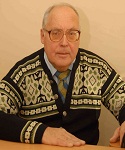| Biography | |
|---|---|
 Prof. Vitaly K. Koltover Institute of Problems of Chemical Physics, Russian Academy of Sciences (IPCP RAS), Russia |
|
| Title: Nuclear Spin Catalysis in Living Nature: Premises and Promises | |
| Abstract:
Cells are composed from atoms of chemical elements, many of which have magnetic and nonmagnetic stable isotopes. In molecular and chemical physics, magnetic isotope effects (MIEs) have long been known for a number of magnetic isotopes, among them 13C, 17O, 29Si, 33S, 73Ge, and 235U [1]. Not long ago, MIEs were discovered in the experiments with living cells enriched with the magnetic isotope of magnesium, 25Mg [2]. Moreover, MIEs were revealed in the experiments with one of the most important molecular motors of cell bioenergetics, myosin isolated from smooth muscle. The rate of the enzymatic ATP hydrolysis is 2.0–2.5 times higher with 25Mg than that with the nonmagnetic 24Mg or 26Mg [3]. Besides, MIE was revealed with zinc. While Zn2+ performs the cofactor function less efficiently than Mg2+ it was found that the rate of the ATP hydrolysis driven by myosin is 40-50 percent higher with the magnetic 67Zn as compared to the nonmagnetic 64Zn or 68Zn [4]. The data of element analysis of the preparations, performed by methods of atomic emission spectrometry and mass spectrometry, testify that the detected differences in the enzyme activity cannot be attributed to any impurity elements in the reaction solutions. Furthermore, the beneficial MIE of 25Mg was discovered in the ATP hydrolysis catalyzed by mitochondrial H+-ATPase (MF0F1 complex) isolated from yeast cells and reconstituted into the proteoliposome membrane. The initial rate of the ATP hydrolysis with 25Mg has turned out to be about 20 percent higher as compared to the rate with the nonmagnetic magnesium isotope [5].
On its own, factual evidence of MIE unambiguously indicates that there is a spin-selective rate-limiting step, a “bottle-neck”, in the process under investigation that is accelerated by the nuclear spins of 25Mg or 67Zn. The most plausible mechanism of the catalytic effect of the nuclear spin can be suggested as follows. The energy released during ATP hydrolysis (~0.54 eV) is not large enough for the electron-conformational transition of the macromolecule into a singlet exited state. This energy is sufficient to produce a low-level triplet state (S = 1) but the transition from the ground state (S = 0) into the triplet (S = 1) is forbidden by the law of conservation of spin. The magnetic isotope’s nuclear spin eliminates the spin ban providing the required conformation transition and, thereby, accelerates the chemo-mechanical cycle of the enzyme. The alternative explanations of the MIEs in the enzymatic hydrolysis of ATP consider a virtual radical-ion pair as the intermediate in the process or increase in the conversion rate of the ortho/para isomers of water molecules by the nuclear spin [6]. Although detailed mechanisms of ability of the biocatalysts to perceive the nuclear magnetism require further investigations, there are the grounds to believe that this new field, nuclear spin catalysis, highlight promising venues for future research with possible application of the stable magnetic isotopes in engineering and medical physics.
| |
| Biography:
Vitaly K. Koltover is a Head Researcher (Principal Investigator) at Department of Kinetics and Catalysis, Institute of Problems of Chemical Physics, the premier organization of Russian Academy of Sciences, in Chernogolovka, Moscow Region, Russia. He holds Master degree in Physics (from Taras Shevchenko University of Kiev, Ukraine, former SU, 1966), PhD degree in Physics (Candidate of Physical and Mathematical Sciences, Chemical Physics, from Institute of Chemical Physics, USSR Academy of Sciences, Moscow, 1971), and SciD degree in Biology (Doctor of Biological Sciences, Biophysics, from the Highest Attestation Committee, Moscow, 1988). He has published more than 250 papers including scientific books and conference proceedings and papers in the representative journals indexed in the Web of Science and Scopus, such as “Biochimica et Biophysics Acta”, “Biophysics”, “Carbon”, “Free Radical Research Communications’”, “Herald of the Russian Academy of Sciences”, “Journal of Molecular Liquids”, “Journal of Physical Chemistry”, “Journal of Theoretical Biology”, “Mendeleev Communications”, “Moscow University Chemistry Bulletin”, “Physics of Solid State”, “Physical Chemistry - Chemical Physics”, “Russian Chemistry Bulletin”. Memberships in professional societies and committees, including Committee on Reliability of Biological Systems at the Scientific Council on the Problems of Biophysics, USSR Academy of Sciences, vice-chairman (1978-1992); Russian Biophysical Society. As invited scientist (visiting professor), he worked in USA (National Lawrence Berkeley Laboratory, University of California, February, 1989, and June, 2002; Department for Biochemistry and Biophysics, University of Pennsylvania, Philadelphia, November-December, 1990; Department of Chemistry, Northwestern University, Evanston, July, 2001). Besides, he worked in Austria (Institute of Pharmacology and Toxicology, Vienna, July, 1991 – June, 1992); Germany (Max-Planck Institute for Demographic Research, Rostock, November, 2004; Institute for Physical Chemistry, Albert-Ludwig University, Freiburg, August, 2011); India (Indian Institute of Technology, Chennai, and Bhabha Atomic Center, Mumbai, January-February, 2002); Israel (Shamoon College of Engineering, Beer Sheva, December, 2011). He presented plenary and oral presentations at scientific meetings in Austria, Canada, China, France, Greece, Italy, Israel, Japan, USA, Ukraine and Russia. Currently, his main research interests are magnetic isotope effects and nuclear spin catalysis in chemistry and biology, chemical nano-bionics, reliability and aging of biological systems.
| |
